An industrial scale process for the enzymatic removal of steryl glucosides from biodiesel
- PMID: 26697112
- PMCID: PMC4687101
- DOI: 10.1186/s13068-015-0405-x
An industrial scale process for the enzymatic removal of steryl glucosides from biodiesel
Abstract
Background: Biodiesels produced from transesterification of vegetable oils have a major quality problem due to the presence of precipitates, which need to be removed to avoid clogging of filters and engine failures. These precipitates have been reported to be mostly composed of steryl glucosides (SGs), but so far industrial cost-effective methods to remove these compounds are not available. Here we describe a novel method for the efficient removal of SGs from biodiesel, based on the hydrolytic activity of a thermostable β-glycosidase obtained from Thermococcus litoralis.
Results: A steryl glucosidase (SGase) enzyme from T. litoralis was produced and purified from Escherichia coli cultures expressing a synthetic gene, and used to treat soybean-derived biodiesel. Several optimization steps allowed for the selection of optimal reaction conditions to finally provide a simple and efficient process for the removal of SGs from crude biodiesel. The resulting biodiesel displayed filterability properties similar to distilled biodiesel according to the total contamination (TC), the cold soak filtration test (CSFT), filter blocking tendency (FBT), and cold soak filter blocking tendency (CSFBT) tests. The process was successfully scaled up to a 20 ton reactor, confirming its adaptability to industrial settings.
Conclusions: The results presented in this work provide a novel path for the removal of steryl glucosides from biodiesel using a cost-effective, environmentally friendly and scalable enzymatic process, contributing to the adoption of this renewable fuel.
Keywords: Biofuels; Green chemistry; Synthetic biology.
Figures
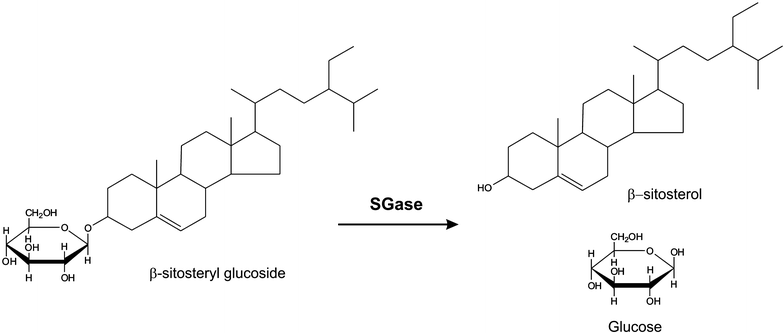
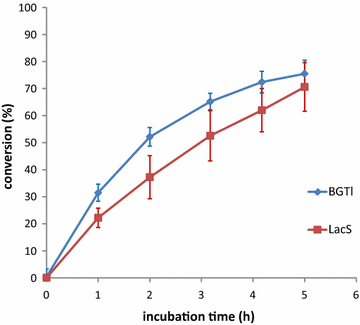
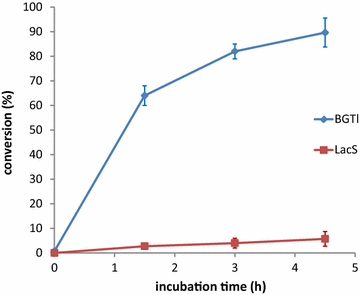

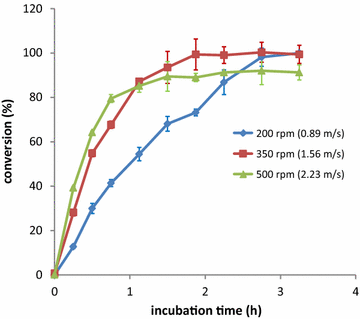
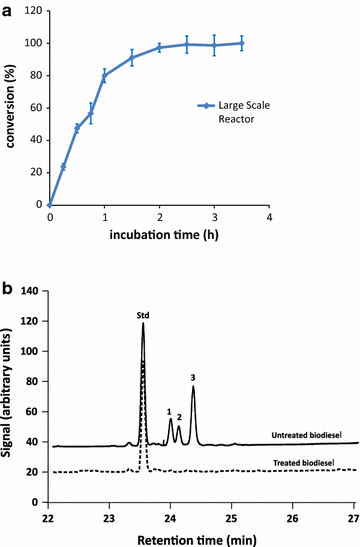
Similar articles
-
Strain engineering and process optimization for enhancing the production of a thermostable steryl glucosidase in Escherichia coli.J Ind Microbiol Biotechnol. 2017 Jan;44(1):141-147. doi: 10.1007/s10295-016-1866-z. Epub 2016 Nov 19. J Ind Microbiol Biotechnol. 2017. PMID: 27866333
-
The production, properties, and applications of thermostable steryl glucosidases.World J Microbiol Biotechnol. 2018 Feb 21;34(3):40. doi: 10.1007/s11274-018-2423-x. World J Microbiol Biotechnol. 2018. PMID: 29468428 Review.
-
Pilot-scale process development for low-cost production of a thermostable biodiesel refining enzyme in Escherichia coli.Bioprocess Biosyst Eng. 2018 Apr;41(4):555-564. doi: 10.1007/s00449-018-1890-7. Epub 2018 Jan 10. Bioprocess Biosyst Eng. 2018. PMID: 29322256
-
Enzymatic hydrolysis of steryl glucosides, major contaminants of vegetable oil-derived biodiesel.Appl Microbiol Biotechnol. 2014 May;98(9):4033-40. doi: 10.1007/s00253-013-5345-4. Epub 2013 Nov 22. Appl Microbiol Biotechnol. 2014. PMID: 24265025
-
Enzymatic transesterification for biodiesel production.Indian J Biochem Biophys. 2003 Dec;40(6):392-9. Indian J Biochem Biophys. 2003. PMID: 22900366 Review.
Cited by
-
Strain engineering and process optimization for enhancing the production of a thermostable steryl glucosidase in Escherichia coli.J Ind Microbiol Biotechnol. 2017 Jan;44(1):141-147. doi: 10.1007/s10295-016-1866-z. Epub 2016 Nov 19. J Ind Microbiol Biotechnol. 2017. PMID: 27866333
-
Biotechnology of extremely thermophilic archaea.FEMS Microbiol Rev. 2018 Sep 1;42(5):543-578. doi: 10.1093/femsre/fuy012. FEMS Microbiol Rev. 2018. PMID: 29945179 Free PMC article. Review.
-
The production, properties, and applications of thermostable steryl glucosidases.World J Microbiol Biotechnol. 2018 Feb 21;34(3):40. doi: 10.1007/s11274-018-2423-x. World J Microbiol Biotechnol. 2018. PMID: 29468428 Review.
References
-
- Lane J. Biofuel mandates around the world: 2015. http://www.biofuelsdigest.com/bdigest/2014/12/31/biofuels-mandates-aroun.... Accessed Jan 23 2015.
-
- OECD-FAO. Agricultural outlook 2011–2020. Paris: OECD Publishing, OECD & FAO. 2011.
-
- Ringwald SC. Biodiesel characterization in the QC environment. The 98th AOCS Annual Meeting Abstracts. Urbana: AOCS Press. 2007. pp. 15.
-
- Tang H, De Guzman R, Salley S, Ng KS. Comparing process efficiency in reducing steryl glucosides in biodiesel. J Am Oil Chem Soc. 2010;87:337–345. doi: 10.1007/s11746-009-1502-4. - DOI
-
- Bondioli P, Cortesi N, Mariani C. Identification and quantification of steryl glucosides in biodiesel. Eur J Lipid Sci Technol. 2008;110(2):120–126. doi: 10.1002/ejlt.200700158. - DOI
LinkOut - more resources
Full Text Sources
Other Literature Sources

